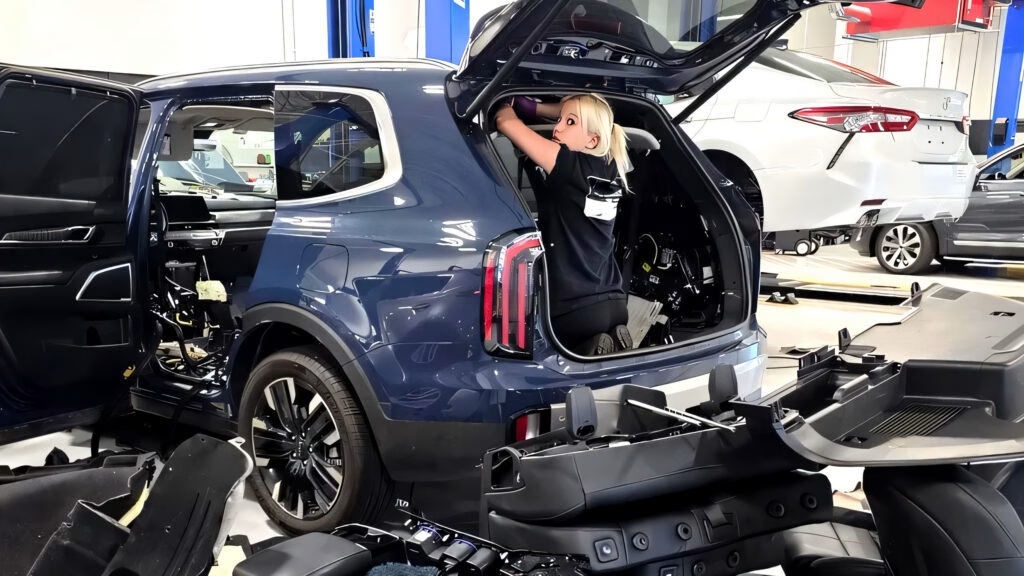What caused the electrical issue in the Kia Telluride?
You’d never guess that something as simple as a pinched wire could sideline a brand-new SUV, but that’s exactly what happened with two Kia Tellurides fresh off the lot. Both vehicles developed electrical shorts traced back to wires squeezed behind the rear speaker housing. The pressure was enough to strip the insulation, letting the ground wire touch power wires and causing a cascade of electrical faults—think rapid turn signals, dead taillights, and blank license plate lights. It’s a classic case of a small manufacturing hiccup snowballing into a much bigger headache.
How did the technician discover the problem?
Emily L., a 20-year-old Kia technician with a knack for details, spotted the first Telluride’s issue during a routine pre-delivery inspection. The SUV had just 10 miles on the clock. She noticed the left turn signal was blinking faster than normal, and none of the rear lights worked. Instead of chalking it up to a fluke, Emily dove in with a multimeter. She found one wire reading 0.1 ohms resistance—way off from the expected open circuit. That told her there was a short to ground, just as the diagnostic code suggested. When a second Telluride rolled in with the same symptoms, she knew it wasn’t a one-off. A little interior surgery revealed the culprit: pinched wires behind the left rear speaker.
Why did Kia choose a full harness replacement instead of a quick repair?
Here’s where things get interesting. Emily’s quick fix—simply unpinching the wires—brought everything back to life. A traditional repair with butt connectors and heat shrink might have taken under an hour and solved the issue for good. But Kia didn’t want to take any chances. Instead, they instructed the dealer to replace the entire floor wiring harness, a job that takes between 7 and 12 hours and requires stripping out seats, carpets, and trim. Why go to such lengths? It’s all about long-term reliability. Even a well-done splice can introduce a tiny bit of resistance, which could trigger future faults or warranty headaches. By swapping the whole harness, Kia eliminates any lingering risk.
What does this say about Kia’s approach to quality and reliability?
Kia’s decision might seem extreme, but it highlights a broader trend in the auto industry: manufacturers are becoming hyper-cautious about electrical issues. With modern vehicles packed to the gills with sensors and computers, a single wiring glitch can have ripple effects across dozens of systems. According to a 2023 report from J.D. Power, electrical and infotainment problems now account for nearly 25% of all new-car complaints. Automakers know that even a minor wiring issue can tank customer satisfaction scores and lead to expensive recalls. By insisting on a full harness replacement, Kia is betting on peace of mind—for both the customer and the brand.
How common are wiring harness failures in new vehicles?
While not an everyday occurrence, wiring harness issues aren’t as rare as you’d hope. As cars get more complex, the number of wires and connectors has exploded. A typical modern SUV can have more than 1,500 individual wires running through it, according to data from the International Automotive Components Group. That’s a lot of opportunity for something to get pinched, crimped, or misrouted on the assembly line. And when it happens, the fix is rarely quick or cheap. Case in point: the Jeep Grand Wagoneer, which recently made headlines for a similar issue that required tearing apart the entire interior to replace a single damaged cable.
Is there a smarter way to prevent these problems in the first place?
Absolutely. Automakers are investing heavily in better quality control and smarter assembly processes. Some are using advanced imaging and AI-powered inspection systems to catch pinched or misrouted wires before the car ever leaves the factory. Others are redesigning harnesses to be more modular, so a small section can be swapped out without gutting the whole interior. For owners, the best defense is a sharp-eyed technician like Emily and a willingness to investigate even minor electrical gremlins before they snowball.
What should owners do if they suspect a wiring issue?
If you notice odd electrical behavior—like flickering lights, warning messages, or malfunctioning signals—don’t ignore it. Document the symptoms and get your vehicle checked by a qualified technician as soon as possible. Early intervention can turn a potential 12-hour repair into a quick fix. And if your car is still under warranty, insist on a thorough inspection. Manufacturers are increasingly willing to go the extra mile to protect their reputation and your safety.
The big takeaway? Electrical reliability isn’t about perfection—it’s about smarter adjustments. Start with one change this week, and you’ll likely spot the difference by month’s end.

